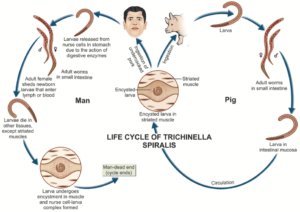
Trichinella spiralis primarily infects animals like pigs and wild boars, but it can also affect humans. The life cycle of this parasite is a complex journey that teaches us a lot about host interactions and the environment. Starting as tiny larvae in one host, they take a winding path that shows just how adaptable these little guys can be. So, let’s explore the stages of Trichinella spiralis and learn a bit about what makes this parasite tick.
Stage 1: Infection of the Host
Trichinella spiralis begins its life cycle when an animal, often a pig, eats raw or undercooked meat containing the larvae. Imagine a hungry pig digging into a delicious meal! Those little larvae are just waiting to get into the pig’s system. Once ingested, they enter the pig’s intestine, where they settle in and start to grow.
Here’s the thing: the pig’s digestive juices help the larvae develop into adult worms. It’s like a transformation from little invaders to full-grown occupants of their new home. Once the adults are ready, they mate inside the intestines. The female worms then release larvae into the bloodstream. You might be wondering how something so small can have such a big impact, but once these larvae enter the bloodstream, they’re on the move!
Stage 2: Migration Through the Body
After leaving the intestines, the larvae travel through the pig’s bloodstream. They are like little ninjas, stealthily navigating their way to various tissues. This migration is crucial for their development. The larvae often find their way into muscle tissue, where they can stay quiet for a long time.
What’s fascinating is that the larvae have a preference for certain muscles, like the diaphragm and tongue. Picture this: a worm choosing its favorite hangout spots in a pig. They encyst, or become encased in a protective capsule, allowing them to survive until another animal consumes the infected meat. This step ensures their survival through nature’s cycle.
Stage 3: Transmission to Humans
Humans usually get infected with Trichinella spiralis by eating undercooked meat from infected animals. It’s an unfortunate twist of fate—one that can lead to a serious illness known as trichinosis. So how does this happen? Let’s say a person enjoys a barbecue with friends, featuring some juicy pork. If that pork isn’t cooked thoroughly, the larvae hidden inside can make their way into their new host—us!
Once in the human intestine, these larvae will hatch and grow into adult worms, just like they did in their pig hosts. It’s a full circle moment, but not one we usually want to experience. That’s why cooking meat to safe temperatures is so important. It can prevent these little invaders from making themselves at home inside your body.
Stage 4: Symptoms and Immune Response
After a person consumes infected meat, symptoms of trichinosis can begin to surface within a week or two. Initially, you might experience digestive issues, like diarrhea or abdominal pain, as the worms take over your intestines. But as they migrate to muscle tissue, more severe symptoms can arise. These may include fever, muscle soreness, and even swelling around the eyes—definitely not fun!
The body’s immune system responds to the invasion. White blood cells identify the larvae as intruders and launch a defense. This fight can cause inflammation, leading to some of those nasty symptoms. It’s like your body is throwing a party to get rid of unwelcome guests. Sometimes, that can feel pretty overwhelming!
Stage 5: Encystment in Human Muscle
After their initial invasion of the intestines and subsequent migration, the larvae find their way into human muscle tissue, where they encyst. Just like in pigs, these encysted larvae can remain dormant for years. If you’ve ever had a friend who just wouldn’t leave your party, you’ll relate to how these larvae behave. They can sit quietly, waiting for another chance to infect a new host.
During this time, they are mostly harmless unless the person is infected with a heavy load of larvae. If that happens, it can lead to more severe symptoms and complications.
Stage 6: The Cycle Continues
The life cycle of Trichinella spiralis is a perfect example of nature’s interconnectedness. Once a human or other host dies, the larvae in the muscle may not have a chance to become encysted, but this doesn’t stop the cycle. If body parts are consumed by another animal in the wild, the larvae can survive and continue the journey.
This cycle emphasizes the importance of being mindful about our food sources and how we prepare them. Respecting food safety and cooking meat properly not only protects us but also breaks the cycle of this parasite.
Understanding the life cycle of Trichinella spiralis gives us a unique glimpse into the world of parasitic interactions. From initial infection to encystment in muscle tissue, these stages show how adaptable and resilient this little worm can be.
As we wrap up, it’s clear that knowledge is power when it comes to protecting ourselves against infections. Cooking meats to safe temperatures and being aware of food sources can prevent many infections, including trichinosis. So, next time you’re enjoying a meal, remember the journey that some of your food has been on. It’s all part of a fascinating web of life!
